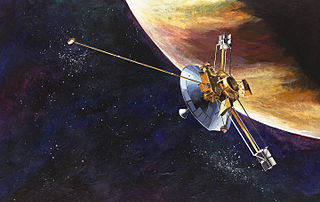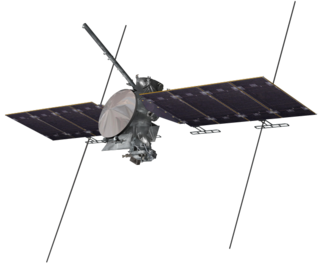
A lander is a spacecraft that descends towards, then comes to rest on the surface of an astronomical body other than Earth. In contrast to an impact probe, which makes a hard landing that damages or destroys the probe upon reaching the surface, a lander makes a soft landing after which the probe remains functional.

The Discovery Program is a series of Solar System exploration missions funded by the U.S. National Aeronautics and Space Administration (NASA) through its Planetary Missions Program Office. The cost of each mission is capped at a lower level than missions from NASA's New Frontiers or Flagship Programs. As a result, Discovery missions tend to be more focused on a specific scientific goal rather than serving a general purpose.
The New Frontiers program is a series of space exploration missions being conducted by NASA with the purpose of furthering the understanding of the Solar System. The program selects medium-class missions which can provide high science returns.

The following outline is provided as an overview of and topical guide to space exploration.

The exploration of Jupiter has been conducted via close observations by automated spacecraft. It began with the arrival of Pioneer 10 into the Jovian system in 1973, and, as of 2023, has continued with eight further spacecraft missions in the vicinity of Jupiter. All of these missions were undertaken by the National Aeronautics and Space Administration (NASA), and all but two were flybys taking detailed observations without landing or entering orbit. These probes make Jupiter the most visited of the Solar System's outer planets as all missions to the outer Solar System have used Jupiter flybys. On 5 July 2016, spacecraft Juno arrived and entered the planet's orbit—the second craft ever to do so. Sending a craft to Jupiter is difficult, mostly due to large fuel requirements and the effects of the planet's harsh radiation environment.

A planetary flyby is the act of sending a space probe past a planet or a dwarf planet close enough to record scientific data. This is a subset of the overall concept of a flyby in spaceflight.

The National Aeronautics and Space Administration is an independent agency of the U.S. federal government responsible for the civil space program, aeronautics research, and space research. Established in 1958, it succeeded the National Advisory Committee for Aeronautics (NACA) to give the U.S. space development effort a distinct civilian orientation, emphasizing peaceful applications in space science. It has since led most of America's space exploration programs, including Project Mercury, Project Gemini, the 1968–1972 Apollo Moon landing missions, the Skylab space station, and the Space Shuttle. Currently, NASA supports the International Space Station (ISS) along with the Commercial Crew Program, and oversees the development of the Orion spacecraft and the Space Launch System for the lunar Artemis program.

The Jupiter Icy Moons Explorer is an interplanetary spacecraft on its way to orbit and study three icy moons of Jupiter: Ganymede, Callisto, and Europa. These planetary-mass moons are planned to be studied because they are thought to have beneath their frozen surfaces significant bodies of liquid water, which would make them potentially habitable for extraterrestrial life.

Europa Clipper is a space probe in development by NASA. Planned for launch in October 2024, the spacecraft is being developed to study the Galilean moon Europa through a series of flybys while in orbit around Jupiter. It is the largest spacecraft NASA has ever developed for a planetary mission.

The Europa Lander is a proposed astrobiology mission concept by NASA to send a lander to Europa, an icy moon of Jupiter. If funded and developed as a large strategic science mission, it would be launched in 2027 to complement the studies by the Europa Clipper orbiter mission and perform analyses on site.

The Planetary Missions Program Office is a division of NASA headquartered at the Marshall Space Flight Center, formed by the agency's Science Mission Directorate (SMD). Succeeding the Discovery and New Frontiers Program Office, it was established in 2014 to manage the Discovery and New Frontiers programs of low and medium-cost missions by third-party institutions, and the Solar System Exploration program of NASA-led missions that focus on prioritized planetary science objectives. The Discovery and New Frontiers programs were established in 1992 and 2001 respectively, and have launched fourteen primary missions together, along with two missions launched under the administration of the Planetary Missions Program Office. The Solar System Exploration Program was established alongside the office, with three missions planned for launch under the new program.

Small Innovative Missions for Planetary Exploration (SIMPLEx) is a planetary exploration program operated by NASA. The program funds small, low-cost spacecraft for stand-alone planetary exploration missions. These spacecraft are intended to launch as secondary payloads on other missions and are riskier than Discovery or New Frontiers missions.









